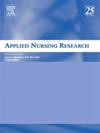光干预对倒班女护士日间嗜睡、疲劳和睡眠质量的影响——一项随机对照试验
IF 2.2
4区 医学
Q1 NURSING
引用次数: 0
摘要
睡眠障碍和疲劳在轮班工作的女性护士中普遍存在,对她们的健康和工作表现产生不利影响。目的探讨光干预对减少轮班女护士日间嗜睡、疲劳及改善睡眠质量的效果。方法在台湾北部某医疗中心进行随机对照试验,将80名女护士分为实验组和对照组。基线评估包括人口统计、工作特征和使用Epworth嗜睡量表(ESS)、简短疲劳量表(BFI)和匹兹堡睡眠质量指数(PSQI)的测量。实验组在四周内每天使用可穿戴照明设备(Re-Timer®)30-40分钟,而对照组则继续他们的日常生活。随访时间分别为第14天(T1)和第28天(T2)。结果广义估计方程(GEEs)分析结果显示,与对照组相比,实验组在T1和T2时嗜睡(ESS)显著减少,睡眠质量(PSQI)显著改善(p < 0.05)。疲劳(BFI)未见明显变化。结论:本研究支持轻干预作为一种安全、低成本和非药物的方法来减少轮班护士白天嗜睡和增强睡眠,建议将其纳入医疗保健提供者的职业健康计划。本文章由计算机程序翻译,如有差异,请以英文原文为准。
Effectiveness of light intervention on daytime sleepiness, fatigue, and sleep quality among female shift-working nurses - A randomized control trail
Background
Sleep disturbances and fatigue are prevalent among female shift-working nurses, adversely affecting their health and job performance.
Objectives
This study aimed to evaluate the effectiveness of light intervention in reducing daytime sleepiness, fatigue, and improving sleep quality among female shift-working nurses.
Methods
A randomized controlled trial was conducted at a medical center in northern Taiwan with 80 female nurses assigned to either an experimental or control group. Baseline assessments included demographics, work characteristics, and measures using the Epworth Sleepiness Scale (ESS), Brief Fatigue Inventory (BFI), and Pittsburgh Sleep Quality Index (PSQI). The experimental group used a wearable light device (Re-Timer®) for 30–40 min daily over four weeks, while the control group continued their usual routines. Follow-up assessments occurred on day 14 (T1) and day 28 (T2).
Results
Results from Generalized Estimating Equations (GEEs) analysis showed significant reductions in sleepiness (ESS) at T2 and improvements in sleep quality (PSQI) at T1 and T2 in the experimental group compared to the control (p < .05). No significant changes were found in fatigue (BFI).
Conclusions
The study supports light intervention as a safe, low-cost, and non-pharmacological approach to reduce daytime sleepiness and enhance sleep in shift-working nurses, suggesting its integration into occupational health programs for healthcare providers.
求助全文
通过发布文献求助,成功后即可免费获取论文全文。
去求助
来源期刊

Applied Nursing Research
医学-护理
CiteScore
4.50
自引率
0.00%
发文量
65
审稿时长
70 days
期刊介绍:
Applied Nursing Research presents original, peer-reviewed research findings clearly and directly for clinical applications in all nursing specialties. Regular features include "Ask the Experts," research briefs, clinical methods, book reviews, news and announcements, and an editorial section. Applied Nursing Research covers such areas as pain management, patient education, discharge planning, nursing diagnosis, job stress in nursing, nursing influence on length of hospital stay, and nurse/physician collaboration.
 求助内容:
求助内容: 应助结果提醒方式:
应助结果提醒方式:


